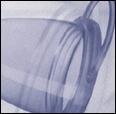|
Type Control-D to bookmark this page!
|
 |
|
|
|

Worried about Pregnancy?

|
|
Barrier Methods for Women
Cervical Cap (FemCap)
Average Failure Rate: 14%
About the Cervical Cap
The cervical cap is a smaller version of the diaphragm. The FemCap is currently the only cap on the market in the US and is a second generation version of older models. Made of a non-allergenic, durable silicone material, the FemCap comes in three sizes and is fitted by your doctor, based on obstetrical history.
The cap is shaped like a sailor hat to conform to a woman's anatomy and is designed to adapt to the physiological changes that occur during the menstrual cycle and intercourse.
The FemCap is placed over the cervix, and is partially
filled with contraceptive jelly or cream. Unlike the diaphragm and older models of the cervical cap, most of the spermicide is put on the side of the cap facing away from the cervix. This means less potential for irritation and allergy in women sensitive to the spermicidal chemicals. In the future, this area will be utilized to also store microbicide (chemicals that kill bacteria and viruses that cause STD's).
If intercourse is repeated, it is
not necessary to reapply spermicide, but you should check to make
sure that the cap is still in place. The cap can be worn for up to 48 hours.
Effectiveness of the FemCap Cervical Cap
|


|
The first-generation FemCap was successful in preventing pregnancy in
87% of the participants during a six-month clinical trial. One pregnancy occurred among the 85 women who completed eight weeks of the study to test the second-generation FemCap. Based on this study, the typical failure rate of the second generation FemCap was estimated to be 8% per year. It is estimated that the FemCap may achieve even higher effectiveness rate up to 96% for perfect users.
The FDA has since approved the second generation cap. Due to the small number of participants and the relatively shorter study duration, the failure rates may be greater or less than was found in clinical trials. Unlike older cervical caps, the FemCap is suitable even for women who have had children, although the failure rate is somewhat higher.
Using the Cervical Cap
Practice inserting and removing your cervical cap before having intercourse.
It can be awkward at first, but becomes easy with practice. During clinical trials women preferred the cap to the diaphragm, and the cap includes a strap to aid in removal.
Nonetheless, some women cannot be fitted for a
cervical cap or cannot easily reach their cervix and must choose
a different form of contraception. Each time you use the cap,
it should be checked for cracks or tears. Replace it if it shows
signs of deterioration or after one year. As with the diaphragm, have the fit rechecked annually and after a pregnancy.
Below are some other cervical caps that are not available in the US.
Featured Links
- At this site:
- The following links are provided as an informational resource or counterpoint and are not necessarily endorsed by the author:

Go to next section
[Lea's Shield]
|







